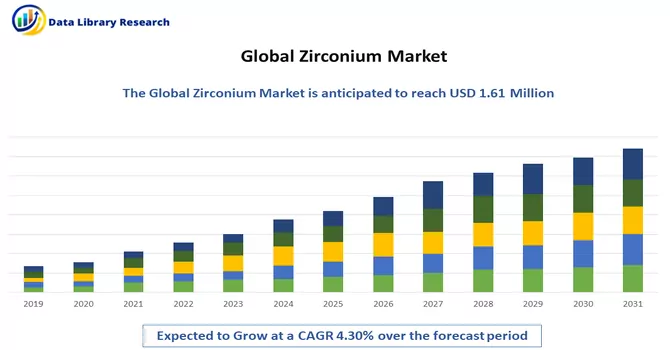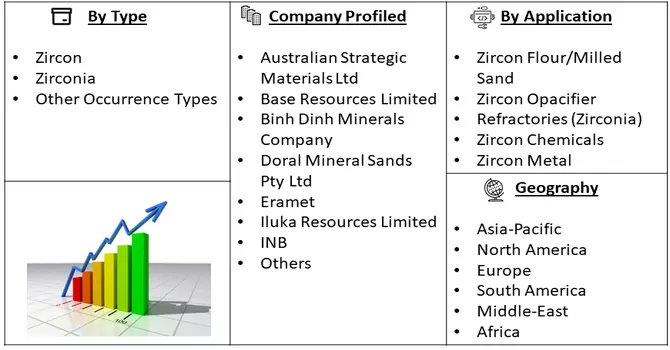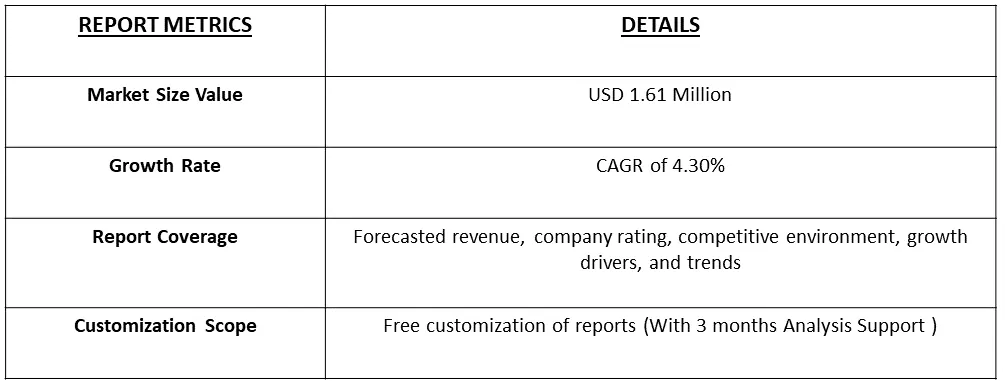The Zirconium Market size is estimated at 1.61 Million tons in 2023 and is expected to reach a CAGR of 4.30% during the forecast period (2024-2031).

Get Complete Analysis Of The Report - Download Free Sample PDF
Zirconium is a chemical element with the symbol Zr and atomic number 40. It is a lustrous, greyish-white, strong transition metal that closely resembles hafnium and is found in a variety of minerals, notably zircon. Zirconium is highly corrosion-resistant due to the formation of a protective oxide layer, making it valuable in various industrial applications. It is commonly used as a cladding material in nuclear reactors due to its low neutron absorption, and its compounds are employed in the production of ceramics, glass, and refractory materials. Zirconium alloys are utilized in aerospace components, while zirconium dioxide finds applications in the manufacturing of high-temperature-resistant ceramics and as a dental material for crowns and bridges. Additionally, zirconium compounds are employed in catalysts, pigments, and various electronic applications, highlighting their versatility across diverse fields.
The Zirconium market is experiencing robust growth driven by several key factors. Increasing demand in industries such as nuclear power generation, aerospace, and ceramics, where zirconium's unique properties, including corrosion resistance and heat tolerance, are highly valued, has significantly contributed to market expansion. Moreover, the rising adoption of zirconium compounds in various applications such as catalysts, pigments, and electronics further propels market growth. The surge in infrastructure development and construction activities worldwide, with zirconium being a crucial component in advanced alloys and refractory materials, adds another dimension to its market expansion. Additionally, the growing use of zirconium in medical applications, such as dental materials, fuels the market's upward trajectory. Overall, the versatile applications of zirconium across diverse industries, coupled with its essential role in critical technologies, position it as a key player in the global market with promising growth prospects.
The zirconium market is undergoing dynamic trends shaped by various factors. The initial setbacks caused by the global economic downturn due to COVID-19-induced lockdowns led to disruptions in zirconium production and demand across vital sectors like iron and steel, cement, energy and chemicals, and ceramics. However, a noteworthy market trend is the expected positive growth trajectory in the forecast period. This resurgence is fueled by a renewed emphasis on developing nuclear power resources globally, creating a demand upswing for zirconium. As countries prioritize nuclear expansion, the zirconium market is poised for recovery and growth, showcasing resilience and adaptability in the post-pandemic economic landscape. Additionally, the versatility of zirconium applications, spanning industries such as aerospace, ceramics, and electronics, further contributes to its enduring market trends.
Market Segmentation: The Zirconium Sand Market is Segmented by Occurrence Type (Zircon, Zirconia, and Other Occurrence Types), Application (Zircon Flour/Milled Sand, Zircon Opacifier, Refractories (Zirconia), Zircon Chemicals, and Zircon Metal), and geography (Europe, North America, Latin America, Asia-Pacific, and the Middle East and Africa). The market sizes and forecasts are provided in terms of value (USD) for all the above segments.

For Detailed Market Segmentation - Download Free Sample PDF
Market Drivers:
The rise in infrastructure development and construction activities worldwide
The rise in global infrastructure development and construction activities has emerged as a significant driver for the zirconium market. Zirconium, known for its high-temperature resistance and corrosion durability, plays a pivotal role in various construction applications, contributing to the strength and longevity of advanced alloys and refractory materials. In particular, zirconium compounds find extensive use in the production of ceramics, which are integral to the construction industry for tiles, bricks, and other structural components. The demand for zirconium is further propelled by its application in nuclear power, a sector often intertwined with large-scale infrastructure projects. As nations continue to invest in expansive construction initiatives, the zirconium market is poised to benefit from the increased need for durable and high-performance materials, marking it as a crucial component in the ever-growing landscape of global infrastructure development.
The growing use of zirconium in medical applications, such as dental materials, and its prevalence in aerospace components
The growing use of zirconium in diverse sectors, notably in medical applications and aerospace components, underscores its versatility and unique properties. In the field of dentistry, zirconium has gained prominence as a material of choice for dental applications, including crowns and bridges. Recognized for its biocompatibility, strength, and aesthetic qualities, zirconium-based dental materials offer a durable and natural-looking alternative. This trend aligns with the increasing demand for advanced dental solutions. Simultaneously, zirconium finds widespread use in aerospace components, owing to its exceptional heat resistance, corrosion stability, and low neutron absorption properties. These characteristics make zirconium alloys crucial for aerospace applications, contributing to the development of lightweight yet robust components for aircraft and spacecraft. The aerospace industry's reliance on zirconium reflects its role in enhancing the performance, durability, and safety of critical components in the demanding conditions of space exploration and aviation. The dual application of zirconium in dental and aerospace domains exemplifies its adaptability and highlights its pivotal role in advancing technology and healthcare.
Market Restraints:
The Supply Chain Vulnerabilities
Furthermore, the zirconium market faces a notable restraint due to vulnerabilities in its supply chain. This vulnerability is rooted in the reliance on the mining and processing of zircon, a crucial raw material for zirconium production. The market is susceptible to geopolitical uncertainties, potential trade restrictions, and logistical challenges associated with the extraction and transportation of zircon. These factors introduce a level of unpredictability, leading to fluctuations in the availability of zirconium. Such uncertainties can, in turn, impact the overall production capabilities of the zirconium market and contribute to pricing volatility. Navigating these supply chain challenges becomes imperative for industry players to maintain stability and resilience in the face of geopolitical and logistical disruptions.
The global economy experienced a notable setback due to a sharp surge in COVID-19 cases, prompting several countries to implement lockdowns that brought about a temporary cessation of economic and industrial activities. This had a profound impact on the zirconium market, disrupting both production and demand across key sectors like iron and steel, cement, energy and chemicals, and ceramics. The widespread economic slowdown resulted in challenges for the zirconium market as these industries faced disruptions in their operations. Nevertheless, a silver lining emerges in the form of an anticipated positive growth trajectory during the forecast period, fueled by a renewed emphasis on developing nuclear power resources. As countries prioritize the expansion of their nuclear capabilities, the demand for zirconium is expected to rebound, presenting opportunities for recovery and growth in the post-pandemic landscape.
Segmental Analysis:
Zircon Segment is Expected to Witness Significant Growth Over the Forecast Period
The zircon and zirconium market is characterized by the extraction of zircon, a silicate mineral rich in zirconium, and its diverse applications across multiple industries. Zircon finds extensive use in ceramics, refractories, foundry casting, and nuclear power generation, contributing to the strength of ceramics, high-performance refractory materials, precision in metal casting, and the cladding of nuclear fuel rods. Geographically, major consumption hubs include the Asia-Pacific region and Europe, driven by industrial and infrastructure development. Recent market developments include DowDuPont's introduction of zirconium oxide for dental implants, aiming to enhance durability in the medical sector, and Alkane Resources Ltd.'s expansion plans for zirconium oxide production to meet growing demand in ceramics and electronics industries. The industry's trajectory is further shaped by advancements in technology, sustainable mining practices, and a commitment to innovation in zirconium applications, positioning it as a key player in materials science, energy, and construction advancements.
Zircon Metal Segment is Expected to Witness Significant Growth Over the Forecast Period
The zircon and zirconium market revolves around the extraction and utilization of zircon, a zirconium silicate mineral, and its derived metal, zirconium. Zircon holds significance as a primary source for obtaining zirconium, a versatile metal with exceptional properties. The market's dynamics are shaped by its widespread applications across diverse industries, encompassing ceramics, refractories, foundry casting, and nuclear power generation. In ceramics, zircon contributes to the strength of tiles, sanitaryware, and decorative ceramics, while in refractories, it plays a crucial role in manufacturing materials resistant to high temperatures. Foundry casting relies on zircon sand for precise and high-quality metal casting. Moreover, the nuclear power sector utilizes zirconium alloys, such as zircaloy, for cladding nuclear fuel rods, owing to its low neutron absorption and corrosion resistance. Geographically, key consumption centers include the Asia-Pacific region and Europe, driven by industrial and infrastructure development. Recent market trends include DowDuPont's launch of zirconium oxide for dental implants, enhancing durability in the medical sector, and Alkane Resources Ltd.'s expansion plans to meet the rising demand for zirconium oxide in ceramics and electronics. As technological advancements and sustainability initiatives shape the industry, the zircon and zirconium market plays a pivotal role in advancing materials science, energy, and construction applications.
Europe Region is Expected to Witness Significant Growth Over the Forecast Period
Europe stands as a significant consumer and contributor to the global zirconium market, with diverse industrial applications driving demand within the region. The zirconium market in Europe finds prominent utilization in various sectors such as ceramics, refractories, nuclear power, and foundry casting. In the ceramics industry, zircon enhances the strength and resilience of tiles, sanitaryware, and decorative ceramics. The refractory sector benefits from zircon's ability to withstand high temperatures, contributing to the manufacturing of robust materials for industrial applications. Zirconium's role in nuclear power is crucial, with the European region utilizing zirconium alloys for cladding nuclear fuel rods, reflecting the commitment to sustainable energy solutions. Additionally, the foundry casting sector in Europe relies on zircon sand to achieve precision and quality in metal casting processes. The zirconium market in Europe is also influenced by environmental and regulatory considerations, prompting industries to adopt sustainable practices and explore eco-friendly alternatives. As the region continues to invest in infrastructure development and technological advancements, the demand for zirconium remains robust. Moreover, the growth of the medical and aerospace sectors further contributes to the increasing consumption of zirconium-based materials. Recent market trends in Europe include a focus on innovation and product development, responding to evolving industrial needs. The region's zirconium market remains dynamic, with key players adapting to changing market dynamics and leveraging technological advancements to maintain competitiveness. Overall, Europe plays a pivotal role in shaping the trajectory of the global zirconium market through its diverse industrial applications and commitment to sustainability.

Get Complete Analysis Of The Report - Download Free Sample PDF
The zirconium market on a global scale exhibits a consolidated nature, where a predominant share is held by the top five companies. These key players significantly influence and contribute to the major portion of global zirconium consumption. The primary regions driving zirconium consumption are the Asia-Pacific and Europe. The demand for zirconium is particularly pronounced in these regions, reflecting the substantial usage and application of the material in various industries. The concentrated market structure, with a few major players dominating, underscores the competitive landscape and strategic positioning within the global zirconium sector. As the Asia-Pacific and Europe continue to be key consumption hubs, the market dynamics and competition among these major companies play a pivotal role in shaping the overall trends and developments within the global zirconium market. Some of the major players are:
Recent Development:
1) In the year 2021, DowDuPont unveiled a novel product line featuring zirconium oxide, specifically designed for application in dental implants. This strategic product launch is geared towards offering top-tier dental implants known for their enhanced durability and prolonged lifespan, thereby generating heightened demand for zirconium oxide within the medical sector.
2) Simultaneously, in 2021, Alkane Resources Ltd. revealed its intentions to undertake an expansion of its Dubbo Project. This project, known for the production of zirconium oxide, is being expanded to meet the surging demand for zirconium oxide observed in the ceramics and electronics industries. These initiatives reflect the proactive responses of key industry players to the growing needs of diverse sectors, positioning zirconium oxide as a sought-after material in both medical and industrial applications.
Q1. What was the Zirconium Market size in 2023?
As per Data Library Research the Zirconium Market size is estimated at 1.61 Million tons in 2023.
Q2. At what CAGR is the Zirconium market projected to grow within the forecast period?
Zirconium market is expected to reach a CAGR of 4.30% during the forecast period.
Q3. What are the factors driving the Zirconium market?
Key factors that are driving the growth include the rise in infrastructure development and construction activities worldwide and The growing use of zirconium in medical applications, such as dental materials, and its prevalence in aerospace components.
Q4. What segments are covered in the Zirconium market Report?
By Occurance Type, By Application and Geography these segments are covered in the Zirconium market Report.
Data Library Research are conducted by industry experts who offer insight on industry structure, market segmentations technology assessment and competitive landscape (CL), and penetration, as well as on emerging trends. Their analysis is based on primary interviews (~ 80%) and secondary research (~ 20%) as well as years of professional expertise in their respective industries. Adding to this, by analysing historical trends and current market positions, our analysts predict where the market will be headed for the next five years. Furthermore, the varying trends of segment & categories geographically presented are also studied and the estimated based on the primary & secondary research.
In this particular report from the supply side Data Library Research has conducted primary surveys (interviews) with the key level executives (VP, CEO’s, Marketing Director, Business Development Manager and SOFT) of the companies that active & prominent as well as the midsized organization
FIGURE 1: DLR RESEARH PROCESS

Extensive primary research was conducted to gain a deeper insight of the market and industry performance. The analysis is based on both primary and secondary research as well as years of professional expertise in the respective industries.
In addition to analysing current and historical trends, our analysts predict where the market is headed over the next five years.
It varies by segment for these categories geographically presented in the list of market tables. Speaking about this particular report we have conducted primary surveys (interviews) with the key level executives (VP, CEO’s, Marketing Director, Business Development Manager and many more) of the major players active in the market.
Secondary ResearchSecondary research was mainly used to collect and identify information useful for the extensive, technical, market-oriented, and Friend’s study of the Global Extra Neutral Alcohol. It was also used to obtain key information about major players, market classification and segmentation according to the industry trends, geographical markets, and developments related to the market and technology perspectives. For this study, analysts have gathered information from various credible sources, such as annual reports, sec filings, journals, white papers, SOFT presentations, and company web sites.
Market Size EstimationBoth, top-down and bottom-up approaches were used to estimate and validate the size of the Global market and to estimate the size of various other dependent submarkets in the overall Extra Neutral Alcohol. The key players in the market were identified through secondary research and their market contributions in the respective geographies were determined through primary and secondary research.
Forecast Model
